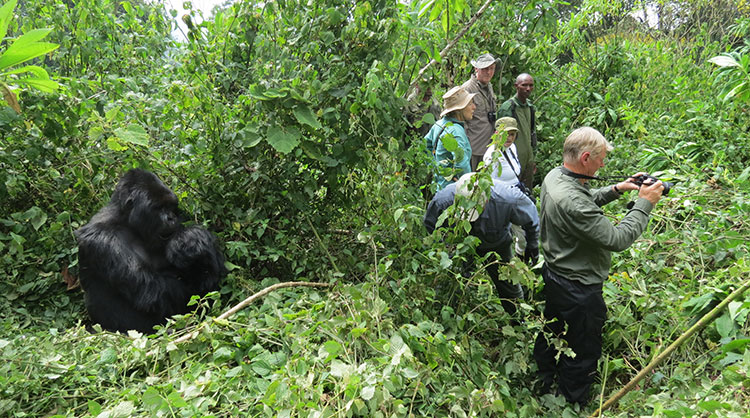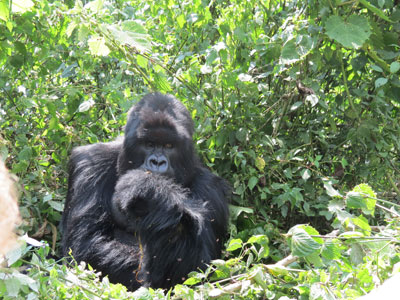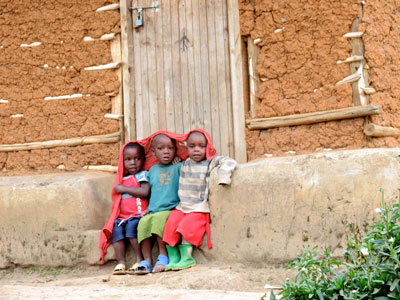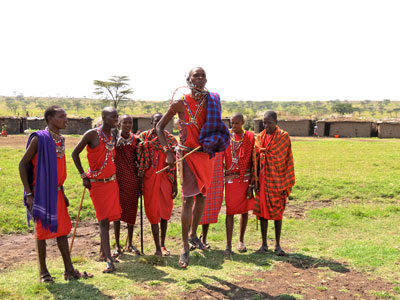African adventures — gorilla tracking in Rwanda plus a Kenyan safari in the Masai Mara
This article appears on page 20 of the May 2013 issue.
by Alla Campbell; Greensboro, Ga.
I have wanted to take a trip to Africa for the great migration for years, so I jumped at the chance when my travel agent told me about a trip for which someone was looking to share accommodations. The trip she told me about was Terra Incognita Ecotours’ “Rwanda: Gorillas in the Mist,” followed by a game safari to Kenya’s Masai Mara during the time of the migration.
I contacted Gerard “Ged” Caddick of Terra Incognita Ecotours (Tampa, FL; 855/326-8687) for details. Ged is almost always available by phone, even if he is out of the country with one of his tours. I quickly signed up and was ready to go.
Getting there
The cost of the Rwanda portion of the trip was $7,499, which included two required viewing permits at Volcanoes National Park to see silverback mountain gorillas. (At that time, the permit cost $500 per day, but the price has gone up to $750.) These permits must be obtained well in advance, since a maximum of eight visitors a day are allowed to observe any one of the 10 groups of habituated gorillas. We would be visiting two groups on our trip.
I used AirTreks (San Francisco, CA; 877/247-8735), which specializes in multidestination travel, to arrange my flight from Atlanta to Kigali, with return from Nairobi. My business-class ticket cost $6,133.
Arriving in Kigali, Rwanda, on July 7, 2012, after a 27-hour flight, I was met by Ged at the Kigali International Airport and transferred to Kigali Serena Hotel, a very modern, comfortable hotel with free WiFi. In fact, in every place we stayed, there was free WiFi.
Everybody on our tour was coming in at different times, so I had plenty of time for relaxing. The evening’s meal was an excellent stir-fry buffet.
Akagera
The next day the group loaded up into four Range Rovers and headed to Akagera National Park, situated in eastern Rwanda on the border of Tanzania. Our group consisted of a man and his college-age daughter, three couples, a single man, five single women and Ged, for a total of 15 people.
We entered the park at the north entrance and drove the entire length of the park to the Akagera Game Lodge. We were not in the park very long when we had our first animal sighting, a Masai giraffe. During our 6-hour drive we saw topi antelopes, waterbucks, Cape buffalo, impalas, zebras and hippopotamus before we even got to the lodge.
There also were many beautiful birds. I love taking photos of birds but usually have to ask someone what I took a photo of. Fortunately, there were several in the group who were serious bird-watchers.
The Akagera Game Lodge was mostly destroyed during the 1994 genocide. There were baboons living in it until 2007, when a renovation was begun. Unfortunately, the 2008 recession stopped the major plans and it was only half completed. Even so, the rooms were adequate and comfortable.
There still are baboons all over the grounds, so you must make certain that all doors are closed and locked in order to keep them out. Area farmers poisoned the lions in the park since they were killing their cattle, but a fence is being built around the park so that lions can be reintroduced.
On our way to Volcanoes National Park the next day, we stopped in Kigali at the Akilah Institute for Women (www.akilahinstitute.org). Started in 2010, the school was cofounded by a young woman from Tampa, Florida, who recognized the untapped talent and abilities of young women in Rwanda. These women were in dire need of an opportunity to further their education and make a difference in their communities.
The first class was to graduate just a few weeks after our visit. The main focus of their education has been the hospitality industry, since Rwanda is becoming a tourist destination and needs good managers and employees in hotels and restaurants. Additional grants and donations are being sought to meet the needs of the students and school. I was very impressed with the young women we met there.
Volcanoes National Park
After lunch at Hôtel Des Mille Collines, an inspiration for the film “Hotel Rwanda,” we went to the Kigali Genocide Memorial Centre. What a sobering yet inspiring memorial! I learned so much about the history of the Hutu and Tutsi, who lived together peacefully until the colonizations by the Germans and then Belgians in the late 1800s led to ethnic distinctions between the groups.
It all came to a head in April 1994, with almost a million Rwandans slaughtered, mostly by machete. The country is now ruled by a seemingly benevolent dictator.
I was struck by Rwanda’s clean streets — no plastic bags anywhere. Also, nobody is allowed to smoke in public.
Our next four nights were spent at the Virunga Lodge, near Volcanoes National Park. What a fabulous place! All the bandas (cottages) overlooked either Bulera or Ruhondo Lake. Our group took over the entire lodge, with two people in each banda.
Meals were excellent and all drinks were free, as was daily laundry service. And there was a hot water bottle in each of our beds every night. What more could you ask for?
We started out early the next day for the headquarters of Volcanoes National Park. We were divided into groups of eight, according to our physical abilities, and met our trackers, porters and guides. Each of us had a porter to carry our daypack and assist as needed during the hikes.
All gratuities to porters, guides, lodge staff, drivers, etc., were included in the cost of our tour. However, the services provided were so excellent that we added our own tips as well.
It took about 1½ hours of hiking over farmland to get into the park, then at least another 45 minutes in the bush to find the gorilla group.
The Umubano Group had 12 members, and they were just lazing around eating and sleeping. We were allowed one hour to observe and photograph them completely in the wild. What a thrill! We tried to stay at least 20 feet away from them (for their protection from our possible diseases), but they came much closer. We just would slowly move away.
On another day we trekked to see the Susa Group, which consisted of 35 gorillas. There were three silverbacks as well as many females and youngsters and a 5-month-old baby. There is no way to describe the feeling of being in the wild following huge gorillas as they wander through thick vegetation eating, playing and resting.
Another day in the park was spent trekking 2½ hours each way to the Karisoke Research Center area, where the Dian Fossey compound and her grave are located. I found it amazing that she was able to get to the area and develop it in the 1970s and ’80s. Originally, there must have been about a dozen buildings over a several-acre area. Concrete pads and the ruins of a dormitory for guests are all that remain.
Dian was murdered in 1985 in the compound, but, because of her work and research, the mountain gorillas are still there for us to visit and protect.
A very important note is that, for each person on the trip, Ecotours donates to the Mountain Gorilla Veterinary Project to help provide any needed health care to these extremely endangered gorillas.
On to Kenya
On July 18, four of us single women continued on to Little Governors’ Camp in Kenya for a game safari. The flight from Kigali to Nairobi cost $232 and the tour extension, $2,999. The price of the Kenya visa ($50), which can be obtained at the airport, was included.
After an hour’s flight in the Governors’ Camp’s private plane, we were ferried across the Mara River to this really luxurious unfenced camp, with 17 wonderful tents. All tents have complete bathrooms, including bidets. Gourmet meals were served outside during lunch and in an open tent at night.
There were resident warthogs roaming through the camp as well as a visiting elephant while we were there.
We were fortunate to have Julius as our driver/guide. We had six extensive game drives in the Masai Mara over four days and saw just about everything there was to see.
Among our sightings were hyenas, baboons, elephants, hippos, black rhinoceros, giraffes, cheetahs, a serval cat (very rare to see), zebras, many types of antelope, many birds, including a secretary bird, mating lions and a leopard, which Julius found in a tree at the end of our last day.
The most exciting thing was to witness a lioness leap out of the tall grass and kill a Cape buffalo. Our guide said that was the first kill he had seen all year.
In addition to taking game drives, we visited a Masai village to see how the people are retaining their culture. And, of course, they had all their crafts set up for our shopping pleasure.
The only disappointment on this extension was that the great migration was late by almost a month, and it still had not started when I left. The grasses in the Serengeti apparently were still plentiful and the animals were in no hurry to move. Guess that means another trip to this fascinating continent!




